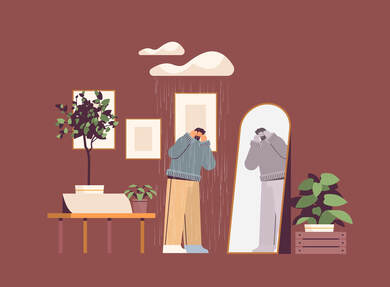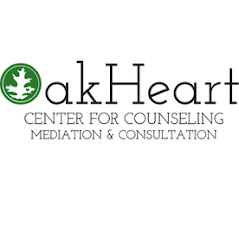Blue Blue ChristmasWritten by Bridgette Koukos, MA, LCPC, NCCWhen you think of the holiday season, I bet you automatically think of things such as holiday parties, ugly sweater contests, eggnog, making gingerbread houses, driving around to see all the holiday lights, and family celebrations. However, this is not always the case for everyone. For some, what should be a time of celebration, is a time of increased depression, and wanting to isolate in the safety of their own home ignoring the fa-la-la-la fun, which can feel like you are on the island of misfit toys.
According to the National Alliance on Mental Illness (NAMI), 64% of people with an existing mental illness report that the holidays make their condition worse. It is no secret that the holiday craziness of cooking, buying and wrapping presents, keeping children entertained, decorating your home, and cleaning up after family gatherings can exacerbate depressive symptoms, and make us feel more overwhelmed and exhausted. This can lead to some individuals feeling immense amounts of guilt for feeling low. While no one goes into the holiday season hoping to feel like a Scrooge, sometimes life situations, family members, or general mental health can trigger the Christmas Blues. If your family is similar to the Griswald’s and drives you crazy, or triggers bad memories that make us want to do anything to steer clear of attending the family holiday party. So how do you deal with a triggering family member? Well here are some helpful tips and tools.
Alternatively, suppose you have good family relationships but cannot spend the holidays with them. In that case, that can also trigger an individual to have increased depressive symptoms, isolate themselves, and exacerbate feelings of loneliness. Below are some helpful tools for this individual to manage a holiday season away from loved ones.
We may feel very Grinch-y this holiday season, but remember you are not the Grinch who lives a lonely life on the top of the mountainside, however, current holiday circumstances can make you feel like you are. But remember whether you are grieving the loss of a loved one this holiday, experiencing unhealthy family dynamics, or feelings an increase in depressive symptoms. Yes, you may find yourself longing for the happier holiday traditions of the past—making the present feel even more miserable. But it is important to remember that with each year, holiday plans, traditions, and experiences will change; yes, this is normal for change to occur. With that said, create your holiday traditions.
Most importantly, for those of us who live in an area such as the Midwest where there is sparse amounts of sunlight during the winter months. To put into perspective, holiday depression impacts approximately 1.5% of Floridians as compared to the approximate 10% in northern/midwestern states. So we need to make sure that we are taking extra steps to help ourselves manage throughout the holiday and winter seasons. This means; making sure you are taking better care of your body (eating healthy, quality sleep, keeping up with hygiene, increasing water intake, etc.). It's important to try and get as much sunlight as possible, so if possible make sure you take time to get outside in the middle of the day when the sun is brightest, or take vitamin D supplements. You can also get a sunlamp. While light therapy is not a cure, it has been shown to help reduce some symptoms of depression. If symptoms of depression continue to worsen and/or intensify please do not hesitate to seek our support here at OakHeart. Overcoming ADHD OverwhelmWritten By Erin Mitchell, MSW, LCSWHave you ever found yourself feeling overwhelmed by tasks, responsibilities, and expectations? Do you find yourself procrastinating until the last possible minute…even if you had a whole day to get it accomplished? Does the task (when you remember to take care of it) feel like there are just too many steps? This is the tip of the iceberg known as overwhelm, especially in the neurodiverse community.
Each person has different tolerances for being overwhelmed and different factors that can contribute For some, feelings of being overwhelmed may stem from physical stimuli (too loud, too many people, uncomfortable clothes, etc.). For others it may be the sheer amount of steps required and feeling like it will take “forever”. While many people with ADHD find that they make decisions very well during times of crisis, they may struggle in making similar decisions without the crisis present to push them along. Signs of Overwhelm:
Coping with Overwhelm:
Getting Tasks Done:
Not all of these things work for everyone at every time, but these can be a good starting point. You are not able to be productive all of the time and you do not need to expect yourself to be. Try things to work with your brain, instead of trying to do things the same way. Different is not bad, just different and you are not alone. If you are looking for more, I recommend checking out this article on ADHD paralysis on ADDitude Magazine: https://www.additudemag.com/slideshows/analysis-paralysis-and-adhd-trouble-making-decisions/ If you are interested in counseling, call OakHeart at 630-570-0050 or 779-201-6440 or email us at [email protected]. We have counselors, psychologists, and social workers available to help you at one of our locations in North Aurora, IL, Sycamore, IL, and/or via Telehealth Online Therapy Services serving Kane County, DeKalb County, Dupage County, and beyond. What is Trichotillomania (Hair-Pulling Disorder)?Written by Elizabeth Grzan, MSW, LSWWhat is a Body-Focused Repetitive Behavior (BFRB)?
Body-Focused Repetitive Behaviors (BFRBs) include any repetitive self-grooming behaviors such as biting, pulling, picking, chewing, or scraping one’s own hair, lips, cheeks, skin, or nails that can lead to physical damage to the body. Often, the individual will make multiple attempts to stop or decrease the behavior but fail to do so. BFRB's fall in a category of disorders called the "Obsessive-Compulsive and Related Disorders." The most common BFRBs are hair pulling (trichotillomania), skin picking (excoriation), nail biting (onychophagia) and cheek biting. There is no one cause for BFRBs; however, there is likely some genetic predisposition which is then triggered by some environmental components. They are "among the most poorly understood, underdiagnosed, and untreated group of mental health disorders" (bfrb.org). Ultimately, there are a vast array of reasons why an individual may engage in BFRB's. Research suggests that some individuals with BFRB's are attempting to improve/correct an imperfection or physical appearance while others may be engaging in BFRB's to regulate intense emotions. Other's may be using BFRB's in response to an intense urge or "tension" without any clear rationale for why. It is important to note, that the goal for an individual with a BFRB is not to self-harm. What is Trichotillomania? According to the fifth edition of the Diagnostic and Statistical Manual (DSM-5-TR) trichotillomania is a "recurrent pulling out of one’s hair" that results in hair loss. The individual must have made repeated attempts to decrease or stop their hair pulling. The hair pulling causes significant distress or impairment in social, occupational or other important areas of functioning. There is no clear consensus on what causes trichotillomania. Some individuals will first struggle with trichotillomania at a very young age while others may start during adolescence. Both men and women can struggle with trichotillomania; however, typically 65%-80% of individuals with trichotillomania are female. Males may be statistically underrepresented as they have more areas to pull from and may be more likely to hide their hair pulling. Individuals who struggle with trichotillomania will typically pull from the scalp, eyebrows, and eyelashes, but they may also pull from other areas such as pubic hair or other areas of their body. There are times when individuals are aware of the hair pulling and are engaging focused pulling (e.g., to make something symmetrical) whereas some of the pulling is more automatic (pulling the hair when they are bored). Focused pulling may encompass rituals such as looking for hair of a specific color/texture (e.g., looking for the one gray hair or the one off colored hair to them). This type of pulling can result in long amounts of time spent on these activities. Individuals with BFRB's may also use tools/implements such as tweezers or mirrors as part of their hair-pulling ritual. The way in which they pull may also become an important part of their ritual. For example, they may attempt to ensure that the hair bulb comes is removed along with the hair strand. There are many identified antecedents to pulling including being bored, experiencing a strong sense of tension (either immediately before pulling out the hair or when attempting to resist the urge to pull), stress or anxiety, or various sensations such as a tactile sensation of something note feeling "right." (e.g., course hair). Some individuals may feel gratification, pleasure, or a sense of relief when they pull the hair. Individuals will report that before they pull that it will feel like an “itch” or a tingly sensation at the scalp that will be alleviated once the hair has been pulled. Pain typically is not accompanied by the hair pulling. Once the hair is pulled individuals will sometimes visually examine the hair or manipulate it. They may run the hair around their face or roll the hair between their fingers. Some may find it soothing to pull the hair between their teeth, biting the hair into multiple pieces or will swallow the hair. However, some individuals will just pull the hair and dispose of it. Treatment Focus The Comprehensive Behavioral (ComB) Model identifies the environmental, motoric, sensory, cognitive and affective antecedents and reinforcing consequences. This model is the most well known to combat BFRBs. Here is a very brief summary of the model: What ComB Does Identifies a range of antecedents of BFRBs Identifies a range of consequences of BFRBs Identifies a range of behavioral sequences of BFRBs Guides individual assessment of BFRBs Guides treatment plan development targeting BFRBs Guides treatment modification as required ComB has 4 Phases. Phase 1: Assessment and Functional Analysis Phase 2: Identify Potential Target Modalities Phase 3: Identify and Choose Treatment Strategies, Implementation of Chosen Interventions Phase 4: Evaluation, Modification, Relapse Prevention Potential Interventions Sensory: distraction, substitution, extinction, medication Cognitive: cognitive restructuring, coping-skills Affective: relaxation, emotive imagery, exposure, medication Motor Habits/Awareness: awareness training, response prevention, competing response training Place and Other Environmental Factors: stimulus control, contingency management References American Psychiatric Association Publishing. (2022). Trichotillomania (Hair-Pulling Disorder). Diagnostic and statistical manual of mental disorders: DSM-5-TR (pp. 282–285). Body-focused repetitive behavior: BFRB: BFRB awareness. TLC Foundation for Body-Focused Repetitive Behaviors. (n.d.). https://www.bfrb.org/your-journey/what-is-a-bfrb#:~:text=Body%2Dfocused%20repetitive%20behaviors%20(BFRBs,stop%20or%20decrease%20the%20behavior. The Benefits of TelehealthWritten by: Dr. Hillary Gorin, PhD, LCPOver the last several years, many people have been hesitant to engage in therapy via telehealth. Why? Because it is a new concept and some fear that it will lead to feeling disconnected from their provider and their treatment goals. Others may fear that their therapy will be less effective if conducted via telehealth. However, I have been providing telehealth mental health services since prior to the pandemic. Not only have I felt equally connected to my patients, but also I have witnessed equally effective and focused treatment via the telehealth modality. This is, in part, because I provide evidence-based, often manualized care. What exactly does that mean? It means that I am often using a structured guide or tool, such as a manual, worksheet, or specific activity/exercise, to ensure that your treatment is effective and supported by research, no matter where you are sitting. Here at Oakheart we value using evidence-based approaches for this reason. When providing evidence-based care via telehealth, treatment has remained highly effective for several reasons and many of my patients have reported the following benefits of completing their treatment virtually.
Time and emotional energy: Patients save time commuting to sessions and therefore they do not need to reserve as much time for sessions if they are conducted via telehealth. If you can carve out exactly 1 hour for your mental health every week, you can engage in effective therapy. After sessions, you can quickly return to your busy life. As noted earlier, evidence based and/ or manualized treatment can be completed anywhere. Most of the time, you will have copies of the worksheets or handouts I am referencing or we will be working on skills application, thought challenging, or homework planning together in sessions. I will ask you to complete many assignments and most practicing will take place outside of the session. In part, this is because each session is only one hour of each week and permanent psychological, behavioral, and neurological changes are only possible if some of the other 168 hours in the week are utilized for practicing skills learned in treatment. If you are participating in exposure-based treatment with me, we will sometimes use the treatment time for completing exposure work, much of which is more effective outside of an office space. Exposure work consists of gradually and repeatedly approaching feared situations, thoughts, memories, sensations, etc. in order to overcome the fear. Many feared situations are present outside of my office space. Therefore, telehealth has allowed me to help my patients with an exposure that required situations in their home or in another space beyond my office. I believe this is why telehealth has actually been a better option for many of my patients with anxiety disorders or OCD, as I have been able to more effectively assist with the exposures. Service access: I work with patients who reside all over Illinois. As long as you are in the state of Illinois, you can access any telehealth provider in Illinois. As a specialist in trauma disorders, anxiety disorders, and OCD, I am able to access so many patients who need specialized care who typically would not be able to work with me due to the location barrier. Flexibility: Wherever you can carve out an hour that aligns with your provider’s availability, you can schedule your session. Telehealth has allowed me to be much more flexible as a provider as well, as I can also work remotely, as needed. Also, when someone needs a session more immediately, I am often able to find a time for them to be seen quickly. Effectiveness: Many patients worry that treatment will be less effective if completed via telehealth. However, my experiences as a provider and research suggests that evidence-based treatments remain highly effective via telehealth, including cognitive behavioral therapy for anxiety disorders (Karpov et al. 2023) and depression (Komariah et al, 2022), exposure and response prevention treatment for OCD (Feusner et al., 2022; Rees et al., 2016), and cognitive behavioral therapy for PTSD (Bisson et al, 2022). In sum, if you are considering telehealth services at Oakheart or with another practice or hospital, your hesitation about this new modality is remarkably valid. However, it appears that telehealth may be the best fit for many patients and that the research corroborates my hypotheses in its effectiveness. It is my commitment as an evidence-based provider to ensure that the modality of treatment I am using will not compromise the care of my patients and I believe that telehealth will remain a fantastic option for effective and expansive mental health services for all individuals in need. If you are interested in counseling, call OakHeart at 630-570-0050 or 779-201-6440 or email us at [email protected]. We have counselors, psychologists, and social workers available to help you at one of our locations in North Aurora, IL, Sycamore, IL, and/or via Telehealth Online Therapy Services serving Kane County, DeKalb County, Dupage County, and beyond. References Bisson, J. I., Ariti, C., Cullen, K., Kitchiner. N., Lewis, C., Roberts, N. P., Simon, N., Smallman, K., Addison, K., Bell, V., Brookes-Howell, L., Cosgrove, S., Ehlers, A., Fitzsimmons, D., Foscarini-Craggs, P. Harris, S. R. S., Kelson, M., Lovell, K., McKenna, M., McNamara, R., Nollette, C., Pickles, T., & Williams-Thomas, R. (2022). Guided, internet based, cognitive behavioural therapy for post-traumatic stress disorder: Pragmatic, multicentre, randomised controlled non-inferiority trial (RAPID). BMJ, 2022; 377, e069405. doi:10.1136/bmj-2021-069405 Feusner, J. D., Farrell, N. R., Kreyling, J., McGrath, P. B., Rhode, A. R., Faneuff, T., Lonsway, S., Mohideen, R., Jurich, J. E., Trusky, L., & Smith, S. M. (2022). Online video teletherapy treatment of obsessive-compulsive disorder using exposure and response prevention: Clinical outcomes from a retrospective longitudinal observational study. Journal of Medical Internet Research, 24(5), e36431. doi: 10.2196/36431 Karpov, B., Lipsanen, J.O., Ritola, V., Rosenström, T., Saarni, S., Pihlaja, S., Stenberg, J., Laizane, P., Joffe, G. The overall anxiety severity and impairment scale as an outcome measure in internet-delivered cognitive behavioral therapy for anxiety disorders: observational study. (2023). J Med Internet Res, 25, e45362. doi: 10.2196/45362 Komariah, M., Amirah, S., Faisal, E. G., Prayogo, S. A., Maulana, S., Platini, H., Suryani, S., Yosep, I., & Arifin, H. (2022). Efficacy of internet-based cognitive behavioral therapy for depression and anxiety among global population during the COVID-19 Pandemic: A Systematic review and meta-analysis of a randomized controlled trial study. Healthcare (Basel). 30;10(7), 1224. doi: 10.3390/healthcare10071224 Rees, C. S., Anderson, R. A., Kane, R. T., & Finlay-Jones, A. L.(2016). Online obsessive-compulsive disorder treatment: Preliminary results of the “OCD? Not Me!” self-guided internet-based cognitive behavioral therapy program for young people. JMIR Ment Health, 3(3), e29. doi: 10.2196/mental.5363 Empowered to Keep LivingWritten by Anna Perkowski, MSW, LCSWSeptember is a month dedicated to suicide awareness and prevention, and this week of the 10 - 16th in particular has been designated as National Suicide Prevention week. I like to associate the word prevention with proactivity - meaning, in order for people to stop attempting and dying by suicide, they need to be first empowered to obtain and/or maintain an increased quality of life. Getting ahead of a suicidal crisis also means that other people, places, and things need to be set in motion before the crisis has an opportunity to occur. I believe that suicide attempts and deaths by suicide do not happen in a vacuum - I think it’s helpful and OK to explore and ask why they occur - and l also believe that no person is to blame for someone’s death by suicide. Suicide prevention is complex and possible. So, what does it mean to be empowered to keep living, and to empower someone to stay alive? According to Oxford, empowerment can be defined as “the process of becoming stronger and more confident, especially in controlling one's life and claiming one's rights.” To me, this sounds a lot like an individual growing in self-esteem and self-compassion and having their personhood acknowledged and respected by others. Below are some practical ways I think together we can work toward creating a world with fewer and fewer deaths by suicide - check it out: Ways to Play an Active Role in Suicide Prevention
If it’d be helpful, I’d invite you to print out this chart and pick a handful of these items to implement into your weeks moving forward to help create a world where more and more people are empowered to keep living, and living well. Suicide prevention is complex and possible.
If you are interested in counseling, call OakHeart at 630-570-0050 or 779-201-6440 or email us at [email protected]. We have counselors, psychologists, and social workers available to help you at one of our locations in North Aurora, IL, Sycamore, IL, and/or via Telehealth Online Therapy Services serving Kane County, DeKalb County, Dupage County, and beyond. Back To School Time: Three Tips To Maintain Mental Health Written by: Lee Ann Heathcoat, MSEd, LCPCBack-to-school time is upon us once again and it can be easy to get caught up in the hustle and bustle of the season. Below are some quick tips to help keep your mental health in check while adjusting to a new school year.
If reading the information provided above resonated with you and you may be a good fit for one of my specializations reach out. I’d like to connect and find out more about how I can support you on your journey. If you are interested in counseling, call OakHeart at 630-570-0050 or 779-201-6440 or email us at [email protected]. We have counselors, psychologists, and social workers available to help you at one of our locations in North Aurora, IL, Sycamore, IL, and/or via Telehealth Online Therapy Services serving Kane County, DeKalb County, Dupage County, and beyond. Simplifying Our LivesWritten by Christina Bieche, MSEd, LCPC, NCCSimplifying our lives is not an easy task especially when it feels like we can never catch a break. Trust me…I get it. Life happens. It happens big. And it can be distracting. Other people rely on you. Things happen outside of your control. And usually not just one thing at a time. But a lot of stuff all at once. It can be overwhelming which makes it hard to stay focused. But you know, that is really what life is….a series of events that just happen – many of which we can’t control or even prepare for! And if we aren’t careful, we can let all the things that happen derail us from what we really want in life. So, how do we stay on track?
The key is to make a daily practice of remembering what you want. And not just the goals that you want but the feelings that you want to feel. For the most part – we are all emotional creatures. All the goals we set, we set because we want to feel a certain way. When you think about the goals you want to set – ask yourself – what are the feelings you are actually going for? Perhaps the finances you want to create are because you want to feel protected and free. Perhaps you want the relationship so that you can feel love and connection. Maybe you want the promotion or ideal job so you can feel worthy. Don’t get me wrong…these are all wonderful things. But – we must also look at the actual end goal. We must start from where we want to end, instead of the other way around. So, look at your goals. Try to find the emotions you are looking for in setting these goals. Let’s say it’s – feeling worthy. So instead of going out and chasing a sense of worth. Ask this question: What can I do today to feel worthy? The answer may surprise you! And how can you remember to never forget this? How can you not get caught up in life? By making this a daily practice…maybe it will be the new way you start each day…and knowing that it will take time to shift the perspective. Be patient! So – what do you want to feel today? And what can your new daily practice of remembering be? If you are interested in counseling, call OakHeart at 630-570-0050 or 779-201-6440 or email us at [email protected]. We have counselors, psychologists, and social workers available to help you at one of our locations in North Aurora, IL, Sycamore, IL, and/or via Telehealth Online Therapy Services serving Kane County, DeKalb County, Dupage County, and beyond. Loving YourselfWritten by Bridgette Koukos, MA, LCPC, NCCThe dictionary definition of the word self-love is defined as an appreciation of one's own worth; proper regard for and attention to one's own happiness or well-being. In my professional experience, I have noticed that a lot of individuals worry that loving and having pride in themselves equates to being conceited or narcissistic. When working on improving your own self-love, that means working on accepting yourself fully, treating yourself with kindness and respect, and helping facilitate your own growth and wellbeing. It not only encompasses how you treat yourself, but also your own thoughts and feelings about yourself. I have to point out that this does not mean having a 24/7 positive view of self, as that may be unrealistic, but we want to get to a place where we can have a majority of positive views and positive treatment of oneself than not. When we are lacking in our own self-love, we often place everything first (i.e., family, friends, community, even career goals) and this is at the expense of our own needs. If this happens then it can manifest into working too hard which can result in burnout and feeling overloaded. It can also cause individual health and wellness issues. Something I have often heard many clients say is, “If my husband/kids/family are happy, or once I reach this career goal, then I will be happy with myself.” You may have even heard yourself say something like, “when I lose X amount of pounds then I will be able to love myself.” Unfortunately, what can happen is that we work hard to achieve this goal without working at the root of the issue, so when that goal is met, we still are unsatisfied with ourselves because we lack love and compassion for ourselves. The importance of self-love is that it is the foundation that allows us to be assertive, set boundaries and create healthy relationships with others, practice self-care, pursue our interests and goals, and ultimately feel proud of who we are. The concept of self-love is simple: it means valuing and caring for your own needs, wants, and desires. It isn’t about being selfish. It is ensuring that you are giving yourself the time and space to recharge, set boundaries and advocate for yourself. With that said, something I say in just about all my sessions at one point to help a client understand fully, is using this example: When you are on a plane, flight attendants remind us the importance of playing with your own oxygen mask first before helping anyone else. They say this because if you were to skip yourself and help others first, you will likely run out of air. When that happens it becomes harder and potentially impossible to help anyone else, including yourself. So how do we start to work on and practice self-love? Well we start with baby steps and work from there. Listed below are some ideas of ways to improve the love for yourself. For starters working on saying at least one (1) nice thing to yourself daily. I typically have my clients work on identifying three (3) things they did well that day. Work on assertiveness skills, as well as boundary setting. This can look something like saying ‘no’ to others or plans. I think this is a great way to work on respecting and loving yourself more. Additionally this allows the opportunity to only take on things we can handle and reduces the frequency of that feeling of burnout or feeling overloaded. For many, they look at self-love as self-care. To practice self-care we need to go to basics and listen to our body, take breaks, and have alone time when needed. Also reconnecting with hobbies and interests. Work on ways to accept your imperfections and live life in accordance with your own personal values and beliefs. Moreover, acknowledge any progress and efforts you have been making. This goes for all areas (i.e., work goals, personal goals, relationship goals, etc.) I think a good way to end this post is with a quote. When we struggle to love ourselves we often talk down to ourselves in a degrading manner. When we love someone, yourself included, we never talk to them in a shameful or humiliating way, so work to treat yourself the way you want to be treated by others and the way you treat your loved ones. If you are interested in counseling, call OakHeart at 630-570-0050 or 779-201-6440 or email us at [email protected]. We have counselors, psychologists, and social workers available to help you at one of our locations in North Aurora, IL, Sycamore, IL, and/or via Telehealth Online Therapy Services serving Kane County, DeKalb County, Dupage County, and beyond. Muscle DysmorphiaWritten by: Dr. Pamela Heilman, PsyD, LCPMuscle Dysmorphia (MD) is a subtype of body dysmorphic disorder that primarily affects men. It is characterized by excessive concern that one’s body is too small and not muscular enough. While MD has some overlap with eating disorders, it is not considered an eating disorder. Individuals with MD may engage in strict eating habits, such as repeatedly counting calories or attempting to establish the perfect balance of carbohydrates, proteins and vitamins in their diets. However, the aim is to bulk up and appear more masculine as opposed to concerns with weight loss as seen in individuals with eating disorders. Additionally, not all individuals with MD have disordered eating (International OCD Foundation).
Compulsive behaviors in those with MD often include camouflaging such as wearing extra layers of clothing to appear larger or baggier clothes to hide a frame that is perceived as too small. It is also common for individuals to engage in excessive weight-lifting, often for several hours a day. Excessively checking mirrors or avoiding them are typical behaviors in MD. Often, social situations where one’s body will be on display, such as beaches or pools, are avoided. As with other forms of body dysmorphic disorder, MD can lead to missing school, work, discontinuation of athletics, or becoming housebound. Some individuals also use anabolic steroids or other performance-enhancing drugs (Phillips, 2005). Cognitive-Behavioral Therapy is considered an effective treatment for muscle dysmorphia. Similar to treatment for other forms of BDD, treatment goals for muscle dysmorphia would include providing psychoeducation, cognitive restructuring, exposure and response prevention, and regular completion of homework assignments. Psychoeducation for muscle dysmorphia would include information on how media and culture influences body image. Strategies for promoting long-term health would also be discussed. This includes helping the client develop realistic expectations regarding nutrition goals and exercise. Cognitive restructuring for MD would involve working with the client to develop more helpful, accurate beliefs about body size and shape. Additionally, it would target unhelpful thoughts, beliefs and behaviors related to altering body shape and weight (Wilhelm, et. al 2013). Exposure and Response Prevention is another important part of treatment. As with BDD, exposures would target situations the client is avoiding such as school, work, or other valued activities. Response prevention would assist the client with identifying all compulsive behaviors related to weight, shape, or muscularity concerns. As previously mentioned, common compulsions may include mirror-checking, comparing, frequent weighting, wearing many layers of clothing to appear bigger, and following an excessive exercise regimen. The therapist and client would develop a plan to help the client stop the compulsions (Wilhelm, et. al 2013). The client would be expected to complete weekly homework assignments associated with these treatment goals. While much research is needed in the areas of BDD and MD, Cognitive-Behavioral Therapy has been shown to be an effective treatment. The references listed below are helpful resources to gain more information on these disorders and on effective treatment. If you are interested in counseling, call OakHeart at 630-570-0050 or 779-201-6440 or email us at [email protected]. We have counselors, psychologists, and social workers available to help you at one of our locations in North Aurora, IL, Sycamore, IL, and/or via Telehealth Online Therapy Services serving Kane County, DeKalb County, Dupage County, and beyond. References: International OCD Foundation (n.d.). Subtypes of BDD. Phillips, K.A. (2005). The broken mirror. Understanding and treating body dysmorphic disorder. Oxford University Press. Wilhelm, S., Phillips, K.A., & Stekette, G. (2013). Cognitive-Behavioral Therapy for Body Dysmorphic Disorder. The Guilford Press. Self-NurturingWritten by Christina Bieche, MSEd, LCPC, NCCIf you find that you're often putting yourself last in order of priority, then some lessons in self-nurturing may be helpful. Since we often give every last bit of our energy and time to our families, jobs, and daily responsibilities…nurturing ourselves becomes even more of a priority.
Why is self-nurturing important? That’s a great question! As popular as the term “self-care” has become, too many of us still tend to forget ourselves in favor of others. Yet, ironically, the more we neglect our own needs, the less able we are to care for our family, our friends, our volunteer causes, and other important areas in life. Let’s remember what the word “nurture” actually means. Originally, it meant “to feed or nourish,” and I believe that can be interpreted both literally and figuratively. You can self-nurture quite literally through the food you eat, but there are so many self-nurturing activities that go far beyond that physical meaning. You can feed your soul by doing the things you love, spending time with people you love, and getting the rest your body needs. If you’re still struggling with the concept of self nurture, think about this. If you’re constantly running on empty, you’re more likely to be impatient with your families or to miss an important deadline at work. Self-nurturing can take a lot or a little bit of time, but all of us need it! Why not think about some of the activities you find refreshing or encouraging, and try to incorporate them into your life today? Here are a few steps you can take to start practicing self-care today:
If you are interested in counseling, call OakHeart at 630-570-0050 or 779-201-6440 or email us at [email protected]. We have counselors, psychologists, and social workers available to help you at one of our locations in North Aurora, IL, Sycamore, IL, and/or via Telehealth Online Therapy Services serving Kane County, DeKalb County, Dupage County, and beyond. |
OakHeart
|
- Home
- Counseling
-
Specialties
- Depression
- Bipolar Disorder
- Anxiety Disorders >
- Obsessive-Compulsive Disorder (OCD)
- Eating Disorders
- Grief and Bereavement
- ADHD
- Maternal Mental Health
- Infertility, Miscarriage, and Neonatal Loss
- Domestic Violence and Sexual Assault
- Posttraumatic Stress Disorder (PTSD) >
- Trauma
- Non-Suicidal Self-Injury (NSSI)
- Substance Use Disorders (SUD)
- Anger Management
- Insomnia
- Divorce Recovery
- Relationship Concerns and Couples Counseling
- Self-Esteem
- Therapy for Therapists
- LGBTQA+ Support
- Faith-Based Counseling
-
Providers
- Erin Mitchell
- Pamela Heilman
- Katie Sheehan
- Hillary Gorin
- Lee Ann Heathcoat
- Adam Ginsburg
- Megan Noren
- Sarah Williams
- Christina Bieche
- Bridgette Koukos
- Laura Lahay
- Kate Nash
- Anna Perkowski
- Alma Lazaro
- Leah Arthur
- Marissa Vogrin
- Erin Blair
- Amy Jakobsen
- Lizzy Lowe
- Tony Fasano
- Gerry Lawm
- Vanessa Osmer
- Kat Harris
- Locations
- Contact
- Treatments
- Employment
- FAQ and Notices
- OakHeart Blog
- Administrative and Leadership Team
- Mental Health Resources
- Divorce Mediation
- Professional Consultation
|
|














